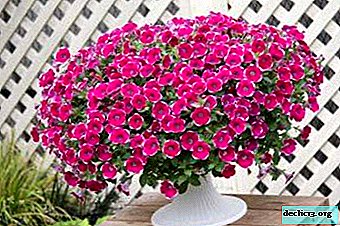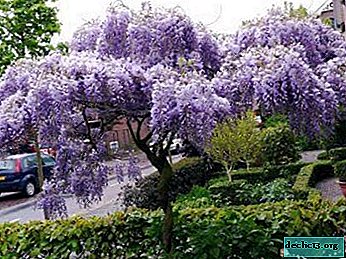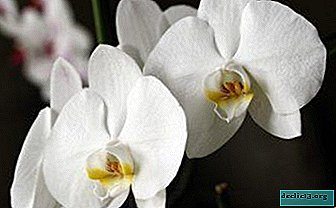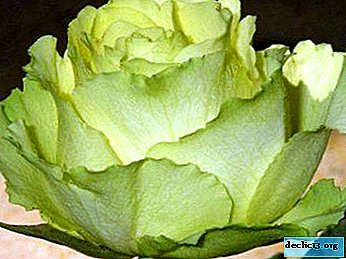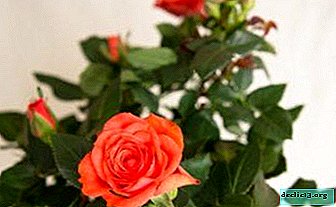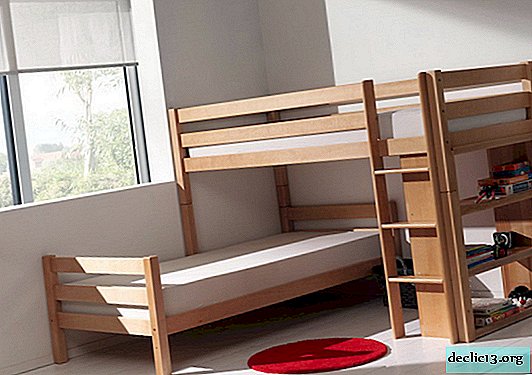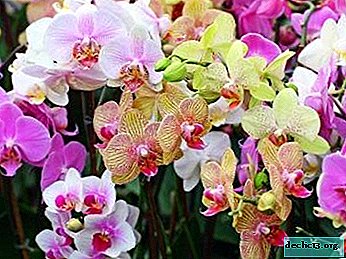Rules for home care for begonia Elatior and the nuances of transplantation
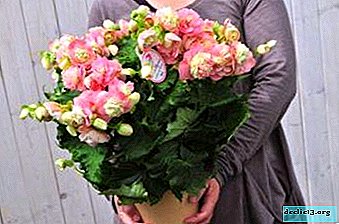
You want in the snowy winter season, when everything around is white, monotonous to please yourself with multi-colored paints.
Then begonia Elatior will be a real find. Her bright flowers look spectacular against a background of glossy green leaves. The lush bushes of this plant are ideal for home windowsills.
In order for a flower beauty to please long flowering, you need to know the rules for its cultivation. Next, we will tell you how to transplant the plant after purchase, as well as about the features of care.
Appearance story
This begonia variety was bred in 1883 by the English breeder Z. Veitch, by cultivating two species. In the process of crossing, Socotransky and tuberous begonias were involved, which made it possible to obtain a plant with non-trivial flowering and excellent decorative properties. We wrote about tuberous begonias in another article.
Botanical features
The Elatior hybrid belongs to the Begonia family, the Begonia family. It is an annual shrub with densely blooming inflorescences.
Depending on the size of begonias there are:
- tall, up to 40 cm high;
- medium-sized - 30 cm;
- stunted, grow about 25 cm.
Hybrids have a dense, developed stem, as well as large, juicy green foliage. The plant has long leaves with an asymmetric shape, the lower part of them is of a light green hue with well-visible veins. Flowers 3-5 cm in size are collected in inflorescences.
Popular varieties:
- Borias.
- Annabelle.
- Baladin.
- Bellona.
- Renaissance.
Photos of popular varieties
The photo shows the popular varieties of "winter" flowers:
Annabelle

Borias

Elatior

Renaissance

Bellona

Growing rules
The flower is quite susceptible to stressful situations, adverse conditions, so caring for him is a troublesome business.
Temperature
Elatior plant is a sensitive flower. In the summer, the temperature in the room should be between + 20-24 ° C. In winter, the required parameters are + 18-20 ° С. The presence of drafts should also be excluded, especially during ventilation. A temperature of + 16 ° C is considered unfavorable for the flower.
Reference. Begonia is afraid of cold weather, not even big frosts are destructive for it, therefore, with the onset of autumn, the plant should be transferred to a warm and bright room. Indicators + 5-9 ° C are critical.Shine
Like other varieties of begonias, Elatior loves light very much, with the exception of penetrating sunlight. After all, they can leave burns on the leaves. Most of all, the plant prefers diffuse lighting.
For comfortable maintenance, begonia should be placed on windows facing east and west. On the north side, the sun is not enough, and on the south side it will be hot in summer. If there is little light, the color of the flower becomes paler, and the inflorescences are smaller.
Begonia has enough of an 8-hour daylight for full development. Therefore, in winter, additional lighting does not need to be built.
Humidity
This parameter is important enough for the hybrid variety. So with dry air in the room, the plant begins to fade, the leaves dry. Humidity should be maintained at the level of 50-70%. This can be done with a household humidifier. Sprinkling water on leaves is strongly discouraged.
Soil requirements and transplantation
 Usually, the soil for the plant becomes ready-made, but you can make it yourself. To prepare it, you should take equal portions of turf, deciduous land and sand. To avoid the development of fungal diseases introduced into the soil, each component must be calcined for 30 minutes.
Usually, the soil for the plant becomes ready-made, but you can make it yourself. To prepare it, you should take equal portions of turf, deciduous land and sand. To avoid the development of fungal diseases introduced into the soil, each component must be calcined for 30 minutes.
It is important that the soil is loose, breathable, enriched with micronutrients. Flowerpots for begonias are preferred small. After all, the plant has an underdeveloped root system, which hardly covers the space prepared for it. The new pot should be 1-2 cm larger than the old.
Attention! Planting and transplanting winter begonias are extremely rare. They are very difficult to tolerate this process, most often the flowers die.As a rule, at the end of flowering, healthy, strong shoots are cut off from the plant, followed by rooting. And the flower itself is eliminated.
Watering
Begonias will be applicable to this variety: it is better to have a deficit of moisture than its excessive amount. The plant does not require intensive watering. In the summer, you need to water when the soil in the pot is covered with a dry crust. Do this carefully so that excess moisture does not get on the leaves.
With excess fluid, the process of decay begins. Begonia can itself show that there is a lack of water. The first signs - the leaves and shoots fade slightly, and after moisturizing, it regains its original shape. Water for irrigation should be soft, clean, without impurities and salts. The plant is so thermophilic that it should even be watered with warm water.
Top dressing
Since the beginning of spring, the flower is necessarily fed. At the beginning of the growth phase, mineral fertilizers with a nitrogen content are used, they stimulate growth. The main thing is not to abuse, which can negatively affect the immunity of the plant. During the flowering period, it is important to feed with fertilizers with a high content of potassium and phosphorus.
Lack of nutrition can affect the appearance of begonia: the tips of the leaves turn yellow, growth slows, lack of lush flowering. Fertilizers should be chosen for decorative-flowering varieties. The preparations Zircon, Master for Flowering Plants, and Epin are not bad.
How to pinch?
 The variety Elatior has a rather intensive growth. In order for the plant to have an attractive appearance, pruning is necessary regularly. Basically, the procedure is done in spring or autumn. The first pruning is done when the sprouts have reached 7-8 cm.
The variety Elatior has a rather intensive growth. In order for the plant to have an attractive appearance, pruning is necessary regularly. Basically, the procedure is done in spring or autumn. The first pruning is done when the sprouts have reached 7-8 cm.
The flower is shaped, it all depends on the wishes of the owner. Then they reduce the amount of watering, until the moment when the plant does not begin to actively develop again. When the shoots are 12-15 cm, the begonia is trimmed a second time.
This time, unnecessary shoots on the sides and top are removed. As a result, lateral kidneys that cannot be allowed to develop can hatch.
If for all the time the plant has not been pruned once, it has an ugly shape. To fix everything, you should cut the lower and upper shoots. It is necessary to remove dried flowers and buds so that they do not take away extra forces and did not spoil the appearance. Cutting is carried out exclusively with a sharpened knife.
When to transplant after purchase?
Quite often, begonia Elatior is bought as a gift in flower shops. And at home, she already needs the right transplant and the acquisition of her permanent place. The best seasons for planting are autumn and spring. This flower is tremulous, and with an early transplant, it can be stressed.
For him, you need to stay in the new conditions for about 7-10 days, to adapt. After you can proceed to the transplant. And if at the time of purchase the begonia is blooming, then be sure to wait until it fades.
Otherwise, the plant will die.
- First of all, in a garden store we buy a soil mixture or prepare it ourselves, the composition is described earlier.
- Then, drainage falls asleep at the bottom of the prepared pot.
- We moisten the soil, only so that it is not very wet.
- Gently extracts begonia from an old flowerpot.
- Shake off the ground.
- The roots are treated with a solution of potassium permanganate.
- Let them dry, and very carefully place the plant in new soil.
Possible problems
 Elatior begonias are not diseased plants. However, flower troubles result from improper care. Especially harmful for the plant is excess moisture, which leads to decay of the root system, disruption in its operation, then the negative process spreads to the foliage. The leaves also begin to dry, rot.
Elatior begonias are not diseased plants. However, flower troubles result from improper care. Especially harmful for the plant is excess moisture, which leads to decay of the root system, disruption in its operation, then the negative process spreads to the foliage. The leaves also begin to dry, rot.
In such an environment, gray rot feels great. To combat this phenomenon, special solutions of fungicides are used, as well as 1% Bordeaux fluid. Increased humidity and a complete lack of ventilation cause the development of powdery mildew, which is characterized by a white coating on the begonia leaves. If measures are not taken in time, the plant, starting from the leaves, dries.
With a similar misfortune they also cope with the help of fungicides. Another disease of dangerous begonias is bacterial spotting. The plant becomes covered with watery spots, which soon turn brown, and the inflorescences and shoots acquire a black color. To treat such an ailment, the soil is treated with disinfectants.
And as a preventative measure, it is enough to treat the flower with a mixture of copper oxychloride. No less than begonia problems can be caused by pests such as aphids, whiteflies, and spider mites. The most effective way to combat them is with insecticides.
If necessary, pick up dried flowers, loosen the soil, wipe the dust from the leaves, inspect the plant for pests. Pay more attention and care to your begonia - a beautiful woman, and in return she will delight with delightful and unique flowering.
Useful video
How to grow begonia Elatior:


